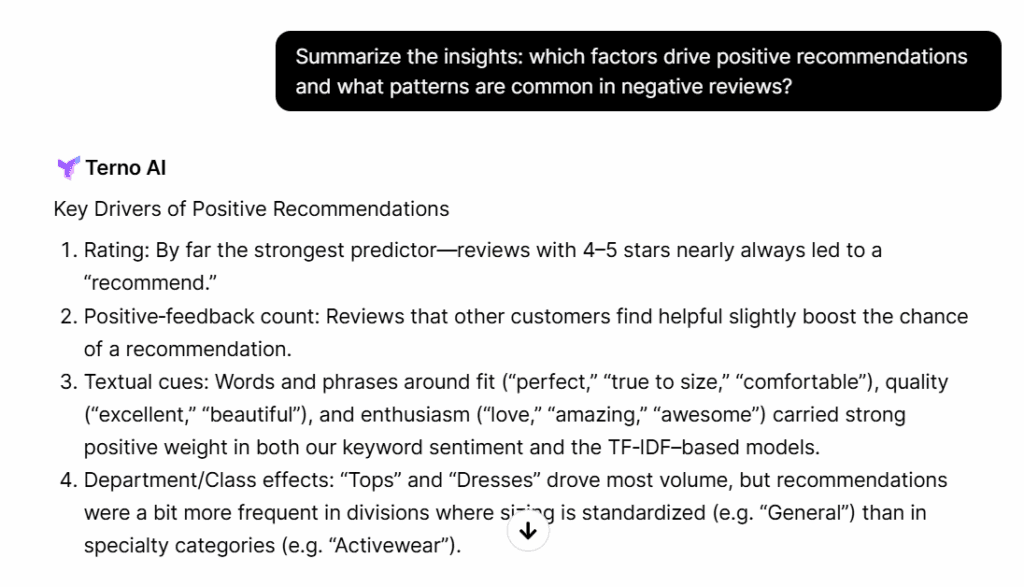Customer Reviews Analysis with Terno-AI
In the digital shopping age, understanding customers means understanding their words. Every review tells a story—why someone loved a product, why they didn’t, and what they expect next. But sifting through tens of thousands of reviews is overwhelming.
That’s where TernoAI comes in. I conducted a comprehensive data science journey on the Women’s E-Commerce Clothing Reviews dataset, not by coding for hours, but by simply asking a few key questions.
Why TernoAI? Turning Curiosity into Analysis
TernoAI is designed for individuals who seek data-driven insights without requiring code. It translates plain English prompts into the heavy lifting of data science: cleaning data, exploring it, building models, and surfacing insights.
All I had to do was ask the right questions. Here’s what happened.
Step 1: Understanding the Data
Prompt: “Perform exploratory data analysis on the dataset, including summary statistics, missing values, and key visualizations for ratings, departments, and recommendations.”
- 23,486 reviews, average reviewer age 43 years (18–99).
- Mean rating: 4.2 stars, with a noticeable skew toward 5‑star ratings.
- Recommendation rate: ~82% of customers would recommend the products.
- Most-reviewed department: Tops (10,468 reviews).
- Missing data: Titles (3,810), review texts (845), and division details (14).





Step 2: What Customers Really Feel
Prompt: “Run sentiment analysis on the review text and show the distribution of positive, neutral, and negative sentiments.”
TernoAI classified all 23,486 reviews:
- Positive: 17,882
- Neutral: 5,057
- Negative: 547



The sentiment analysis showed that most reviews were overwhelmingly positive, with the word cloud highlighting frequently used expressions of satisfaction such as ‘perfect,’ ‘comfortable,’ ‘beautiful,’ ‘love,’ and ‘amazing.’
Step 3: Predicting Recommendations
Prompt: “Build and compare models to predict whether a review recommends the product (‘Recommended IND’) using review text, ratings, and other features. Evaluate with accuracy, precision, recall, and F1‑score.”

| Model | Accuracy | Precision | Recall | F1‑score |
|---|---|---|---|---|
| Logistic Regression | 0.9399 | 0.9616 | 0.9652 | 0.9634 |
| Random Forest | 0.9296 | 0.9426 | 0.9733 | 0.9577 |
Step 4: What Drives Positive (and Negative) Recommendations?
Prompt: “Summarize the insights: which factors drive positive recommendations and what patterns are common in negative reviews?”


TernoAI’s findings were clear:
- Rating is the strongest driver—4–5 star ratings almost always lead to recommendations.
- Positive feedback count matters—reviews marked as helpful slightly improve the likelihood of a recommendation.
- Textual cues: Words around fit (“true to size,” “comfortable”), quality (“excellent,” “beautiful”), and enthusiasm (“love,” “amazing”) dominate positive recommendations.
- Negative reviews often cite inconsistent sizing, poor fit, or fabric quality.
The No‑Code Advantage
In just four prompts, I accomplished:
- Full EDA with clear visualizations
- Sentiment analysis with distribution insights and visualisations
- Predictive modeling with side‑by‑side algorithm comparison.
- Actionable findings to guide product improvements
All of this—without a single line of manual coding. No debugging, no setup headaches, just fast and accurate results.
Why This Matters
For fashion retailers, understanding what customers genuinely love—and where they feel let down—is mission‑critical. With TernoAI, teams can:
- Identify the features that drive recommendations
- Quickly uncover recurring issues in negative feedback
- Refine products, sizing, and design based on authentic customer voices
- Strengthen loyalty by turning feedback into action
Final Takeaway: Turning Feedback into Action
TernoAI transforms data science into a simple conversation. With a few well‑chosen prompts, I uncovered powerful insights from thousands of e‑commerce reviews—insights that can immediately influence product strategy, marketing, and customer experience.
The next time you’re buried under an avalanche of unstructured customer feedback, remember: with TernoAI, actionable answers are just a prompt away.
Chat source: https://nishtha.app.terno.ai/chat/share/1ef8ca0d-2080-406c-aed6-b6dd7bf9c644